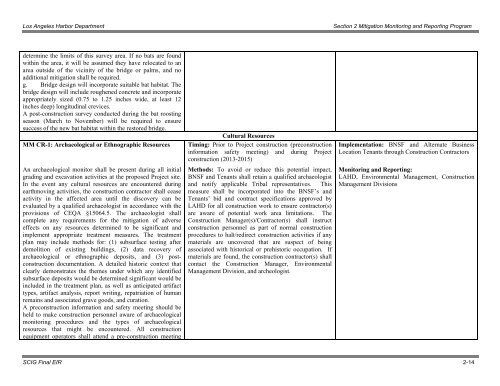Final Mitigation Monitoring and Reporting Program (MMRP)
Final Mitigation Monitoring and Reporting Program (MMRP)
Final Mitigation Monitoring and Reporting Program (MMRP)
Create successful ePaper yourself
Turn your PDF publications into a flip-book with our unique Google optimized e-Paper software.
Los Angeles Harbor Department Section 2 <strong>Mitigation</strong> <strong>Monitoring</strong> <strong>and</strong> <strong>Reporting</strong> <strong>Program</strong><br />
determine the limits of this survey area. If no bats are found<br />
within the area, it will be assumed they have relocated to an<br />
area outside of the vicinity of the bridge or palms, <strong>and</strong> no<br />
additional mitigation shall be required.<br />
g. Bridge design will incorporate suitable bat habitat. The<br />
bridge design will include roughened concrete <strong>and</strong> incorporate<br />
appropriately sized (0.75 to 1.25 inches wide, at least 12<br />
inches deep) longitudinal crevices.<br />
A post-construction survey conducted during the bat roosting<br />
season (March to November) will be required to ensure<br />
success of the new bat habitat within the restored bridge.<br />
MM CR-1: Archaeological or Ethnographic Resources<br />
An archaeological monitor shall be present during all initial<br />
grading <strong>and</strong> excavation activities at the proposed Project site.<br />
In the event any cultural resources are encountered during<br />
earthmoving activities, the construction contractor shall cease<br />
activity in the affected area until the discovery can be<br />
evaluated by a qualified archaeologist in accordance with the<br />
provisions of CEQA §15064.5. The archaeologist shall<br />
complete any requirements for the mitigation of adverse<br />
effects on any resources determined to be significant <strong>and</strong><br />
implement appropriate treatment measures. The treatment<br />
plan may include methods for: (1) subsurface testing after<br />
demolition of existing buildings, (2) data recovery of<br />
archaeological or ethnographic deposits, <strong>and</strong> (3) postconstruction<br />
documentation. A detailed historic context that<br />
clearly demonstrates the themes under which any identified<br />
subsurface deposits would be determined significant would be<br />
included in the treatment plan, as well as anticipated artifact<br />
types, artifact analysis, report writing, repatriation of human<br />
remains <strong>and</strong> associated grave goods, <strong>and</strong> curation.<br />
A preconstruction information <strong>and</strong> safety meeting should be<br />
held to make construction personnel aware of archaeological<br />
monitoring procedures <strong>and</strong> the types of archaeological<br />
resources that might be encountered. All construction<br />
equipment operators shall attend a pre-construction meeting<br />
Cultural Resources<br />
Timing: Prior to Project construction (preconstruction<br />
information safety meeting) <strong>and</strong> during Project<br />
construction (2013-2015)<br />
Methods: To avoid or reduce this potential impact,<br />
BNSF <strong>and</strong> Tenants shall retain a qualified archaeologist<br />
<strong>and</strong> notify applicable Tribal representatives. This<br />
measure shall be incorporated into the BNSF’s <strong>and</strong><br />
Tenants’ bid <strong>and</strong> contract specifications approved by<br />
LAHD for all construction work to ensure contractor(s)<br />
are aware of potential work area limitations. The<br />
Construction Manager(s)/Contractor(s) shall instruct<br />
construction personnel as part of normal construction<br />
procedures to halt/redirect construction activities if any<br />
materials are uncovered that are suspect of being<br />
associated with historical or prehistoric occupation. If<br />
materials are found, the construction contractor(s) shall<br />
contact the Construction Manager, Environmental<br />
Management Division, <strong>and</strong> archeologist.<br />
Implementation: BNSF <strong>and</strong> Alternate Business<br />
Location Tenants through Construction Contractors<br />
<strong>Monitoring</strong> <strong>and</strong> <strong>Reporting</strong>:<br />
LAHD, Environmental Management, Construction<br />
Management Divisions<br />
SCIG <strong>Final</strong> EIR 2-14
















